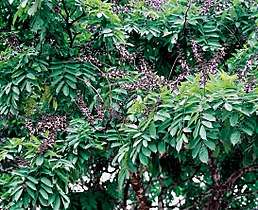Millettia
| Millettia | |
|---|---|
 | |
| M. laurentii, foliage and flowers | |
| Scientific classification | |
| Kingdom: | Plantae |
| (unranked): | Angiosperms |
| (unranked): | Eudicots |
| (unranked): | Rosids |
| Order: | Fabales |
| Family: | Fabaceae |
| Subfamily: | Faboideae |
| Tribe: | Millettieae |
| Genus: | Millettia |
| Species | |
|
See text. | |
| Synonyms[2] | |
| |
Millettia is a genus of legume in the Fabaceae family. It consists of about 150 species, which are distributed in the tropical and subtropical regions of the world.
Description
In 1834, in Prodromus Florae Peninsulae Indiae Orientalis Robert Wight and George Arnott Walker-Arnott describe Millettia as:
Calyx cup-shaped, lobed or slightly toothed. Corolla papilionaceous: vexillum recurved, broad, emarginate, glabrous or silky on the back. Stamens diadelphous (9 and 1), the tenth quite distinct. Legume flat, elliptic or lanceolate, pointed, coriaceous, thick margined, wingless indehiscent, 1-2 seeded: valves closely cohering with each other all round the seeds and between them. Twining or arboreous. Leaves very large, unequally pinnated: leaflets opposite, with a setaceous partial stipule at the base of each partial petiole. Racemes axillary, more or less branched and compound. Flowers pretty large, purplish, pedicelled on shortish diverging partial peduncles.[3]
Etymology
Long known to residents of the Indies, China, and Africa, this species has had many traditional names. One of the oldest references in traditional Chinese medicine is in Bencao Gangmu Shiyi ("Supplement to Compendium of Materia Medica") where is called jixueteng. The Chinese name literally translates to "stem of chicken's blood" which refers to the red resin present in the stems of several climbing legume shrubs.[4]
In the 1820s-1830s Charles Millett, a plant collector and an official with the East India Company, collected many samples of Millettia while living in Canton and Macao. He sent them to the University of Glasgow's Botanical Garden. In 1834, Robert Wight and George Arnott Walker-Arnott, both Scottish botanists, published Prodromus Florae Peninsulae Indiae Orientalis where the genus Millettia is first mentioned. The authors named the genus after Charles Millett, incorrectly referring to him as Dr. Charles Millett.[3] Charles Millett of the East India Company has often been confused with Charles Millet, a French ichthyologist, who was active around the same time.[5] In addition J. A. Millet, a French botanist from the 18th century, is often misattributed as the source.[6]
Uses
The species Millettia pinnata has been investigated for use as biofuel.[7]
Species
Species include:
- Millettia aurea
- Millettia australis - Samson's sinew (Norfolk Island)
- Millettia brandisiana
- Millettia bussei
- Millettia capuronii
- Millettia conraui
- Millettia decipiens
- Millettia diptera Gagnep.
- Millettia duchesnei
- Millettia elongistyla
- Millettia eriocarpa
- Millettia galliflagrans
- Millettia grandis – Umzimbeet
- Millettia hitsika
- Millettia lacus-alberti
- Millettia laurentii – Wengé
- Millettia leucantha
- Millettia macrophylla
- Millettia micans
- Millettia mossambicensis
- Millettia nathaliae
- Millettia nigrescens Gagnep.
- Millettia nitida
- Millettia orientalis
- Millettia pachycarpa
- Millettia peguensis
- Millettia pinnata
- Millettia psilopetela
- Millettia pterocarpa
- Millettia pubinervis Kurz
- Millettia puerarioides Prain
- Millettia richardiana
- Millettia rhodantha
- Millettia sacleuxii
- Millettia schliebenii
- Millettia semsei
- Millettia sericantha
- Millettia stuhlmannii – Panga panga
- Millettia sutherlandii
- Millettia taolanaroensis
- Millettia thonningii
- Millettia unifoliata
- Millettia usaramensis – Lesser millettia
- Millettia utilis
- Millettia warneckei
References
- ↑ Millettia Wight & Arn. Archived 2010-05-29 at the Wayback Machine., Germplasm Resources Information Network (GRIN)
- ↑ Kew
- 1 2 Wight, Robert; Arnott, George Arnott Walker (1834). Prodromus Florae Peninsulae Indiae Orientalis: Containing Abridged Descriptions of the Plants Found in the Peninsula of British India, Arranged According to the Natural System, Volume 1. p. 263.
- ↑ Subhuti Dharmananda. "MILLETTIA (jixueteng)".
- ↑ M. Charters. "The Eponym Dictionary of Southern African Plants — Plant Names L-O".
- ↑ Sue Eland. "Galedupa - Plant Biographies" (PDF).
- ↑ Scott, Paul T.; Pregelj, Lisette; Chen, Ning; Hadler, Johanna S.; Djordjevic, Michael A.; Gresshoff, Peter M. (2008), "Pongamia pinnata: an Untapped Resource for the Biofuels Industry of the Future", BioEnergy Research, 1: 2, doi:10.1007/s12155-008-9003-0